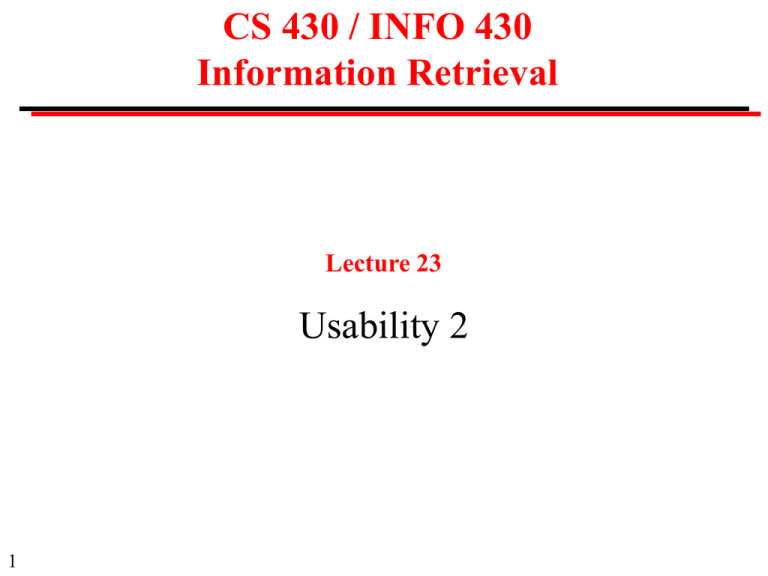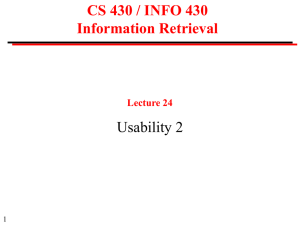CS 430 / INFO 430 Information Retrieval Usability 2 Lecture 23
advertisement

CS 430 / INFO 430 Information Retrieval Lecture 23 Usability 2 1 Course Administration Wednesday, November 16 No discussion class Thursday, November 17 No lecture No office hours 2 Course Administration Assignment 3 Grades were returned yesterday If you have any questions, send email to cs430-l@lists.cs.cornell.edu Replies may be delayed until next week 3 Usability Factors in Searching Example: Design an interface for a simple fielded search. Interface: Fill in boxes, text string, ... ? Presentation of results ... ? Manipulation of results ... ? Functions: Specify field(s), content, operators, ... ? Retain results for manipulation ... ? Query options ... ? 4 Data: Metadata formats ... ? Data structures and file structures ... ? Systems: Performance ... ? The Design/Evaluate Process Requirements (needs of users and other stakeholders) Evaluation start Implementation (may be prototype) release 5 Design (creative application of design principles) Evaluation What is usability? Usability comprises the following aspects: • Effectiveness – the accuracy and completeness with which users achieve certain goals Measures: quality of solution, error rates • Efficiency – the relation between the effectiveness and the resources expended in achieving them Measures: task completion time, learning time, clicks number • Satisfaction – the users’ comfort with and positive attitudes towards the use of the system Measures: attitude rating scales From ISO 9241-11 6 Evaluation • The process of determining the worth of, or assigning a value to, the usability on the basis of careful examination and judgment. • Making sure that a system is usable before launching it. • Iterative improvements after launch. • Categories of evaluation methods: – Analytical evaluation: without users – Empirical evaluation: with users – Measurements of operational systems 7 Evaluation without Users Assessing systems using established theories and methods Evaluation techniques • Heuristic Evaluation (Nielsen, 1994) – Evaluate the design using “rules of the thumb” • Cognitive Walkthrough (Wharton et al, 1994) – A formalized way of imagining people’s thoughts and actions when they use the interface for the first time • Claims Analysis – based on scenario-based analysis – Generating positive and negative claims about the effects of features on the user 8 Evaluation with Users Testing the system, not the users! Stages of evaluation with users: Preparation Sessions conduct Analysis of results User testing is time-consuming and expensive. 9 Evaluation with Users Preparation • Determine goals of the usability testing “The user can find the required information in no more than 2 minutes” • Write the user tasks “Answer the question: how hot is the sun?” • Recruit participants Use the descriptions of users from the requirements phase to detect potential users 10 Usability Laboratory Concept: monitor users while they use system Evaluators one-way mirror 11 User Evaluation with Users Sessions Conduct • Conduct the session – Usability Lab – Simulated working environment • Observe the user – Human observer(s) – Video camera – Audio recording • Inquire satisfaction data 12 Evaluation with Users Results Analysis • If possible, use statistical summaries • Pay close attention to areas where users – were frustrated – took a long time – couldn't complete tasks • Respect the data and users' responses, don't make excuses for designs that failed • Note designs that worked and make sure they're incorporated in the final product 13 Measurements on operational systems Analysis of system logs • Which user interface options were used? • When was was the help system used? • What errors occurred and how often? • Which hyperlinks were followed (click through data)? Human feedback • Complaints and praise • Bug reports • Requests made to customer service 14 The Search Explorer Application: Reconstruct a User Sessions 15 Refining the design based on evaluation Designers and evaluators need to work as a team Designers are poor evaluators of their own work, but know the requirements, constraints, and context of the design: • Some user problems can be addressed with small changes • Some user problems require major changes • Some user requests (e.g., lots of options) are incompatible with other requests (e.g., simplicity) Do not allow evaluators to become designers 16 Usability experiment: Ordering of results The order in which the hits are presented to the user: • Ranked by similarity of match (e.g., term weighting) • Sorted by a specified field (e.g., date) • Ranked by importance of document as calculated by some algorithm (e.g., Google PageRank) • Duplicates shown separately or merged into a single record • Filters and other user options What impact do these choices have on the usability? 17 Experiment on the Google Interface Methodology • 10 information seeking tasks in 2 categories • Users randomized across tasks • Click-through data to see what the user did • Eye tracking data to see what the user viewed • Google results presented with top ten ranks reversed An example of interdisciplinary information science research by Cornell's Human Computer Interaction Group and Computer Science Department 18 Evaluation Example: Eye Tracking 19 Evaluation Example: Eye Tracking 20 Google Evaluation Click-Through Data Number of users who clicked on link Rank of hit 21 Google Evaluation Eye Tracking Data Number of users who viewed short record before first click 350 300 250 200 150 100 50 0 1 2 3 4 Rank of hit 22 5 6 7 8 9 10 Google Evaluation: Eye Tracking Data Part of short record viewed before first click (% of users) Title: 17.4% Snippet: 42.1% Category: 1.9% URL: 30.4% Other: 8.2% (includes, cached, similar pages, description) 23 Google Experiment: Click Through Data with Ranks Reversed ChosenRank Percentage of users who clicked on link Cond: r 80 Percent 60 40 20 0 1 2 3 4 5 ChosenRank 6 Rank of hit 24 8 9 10

